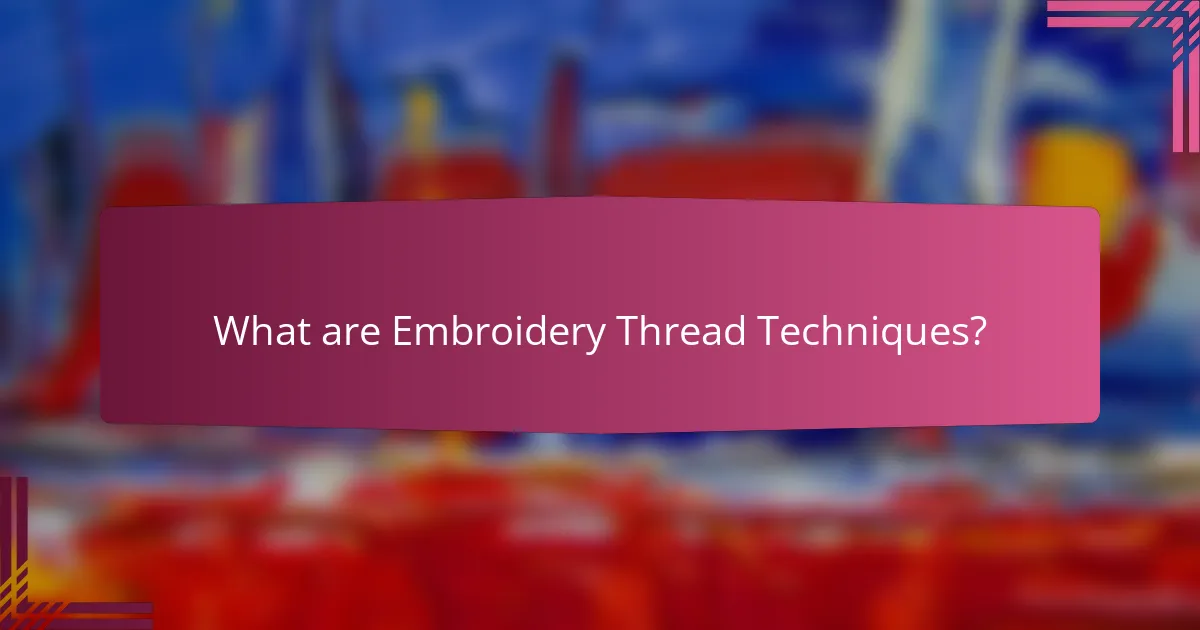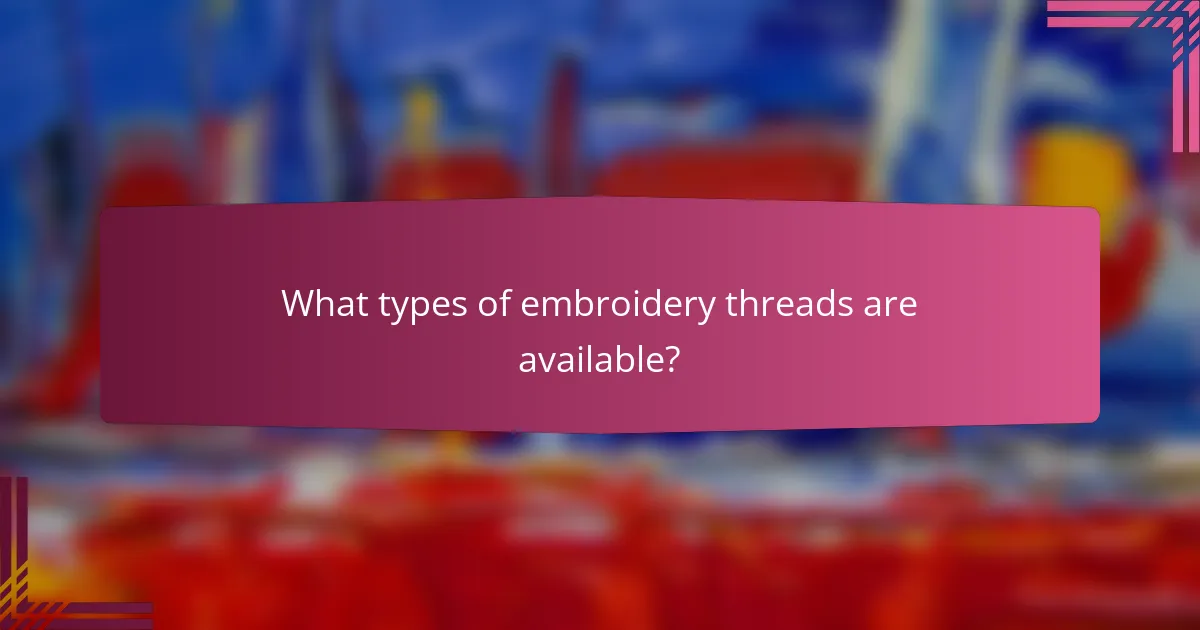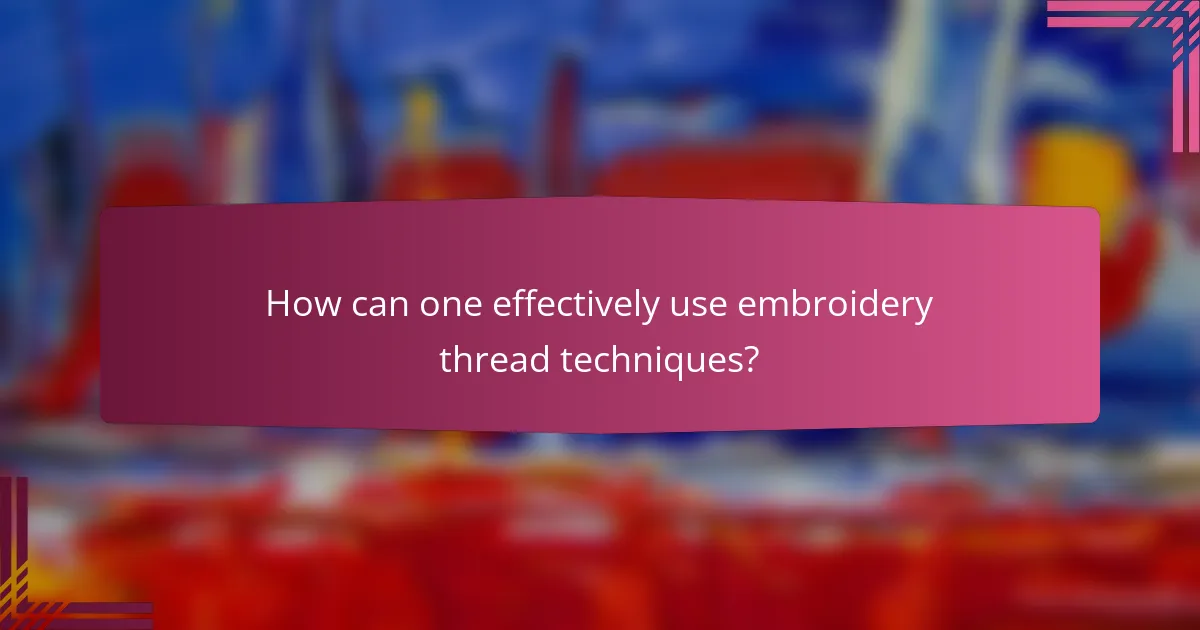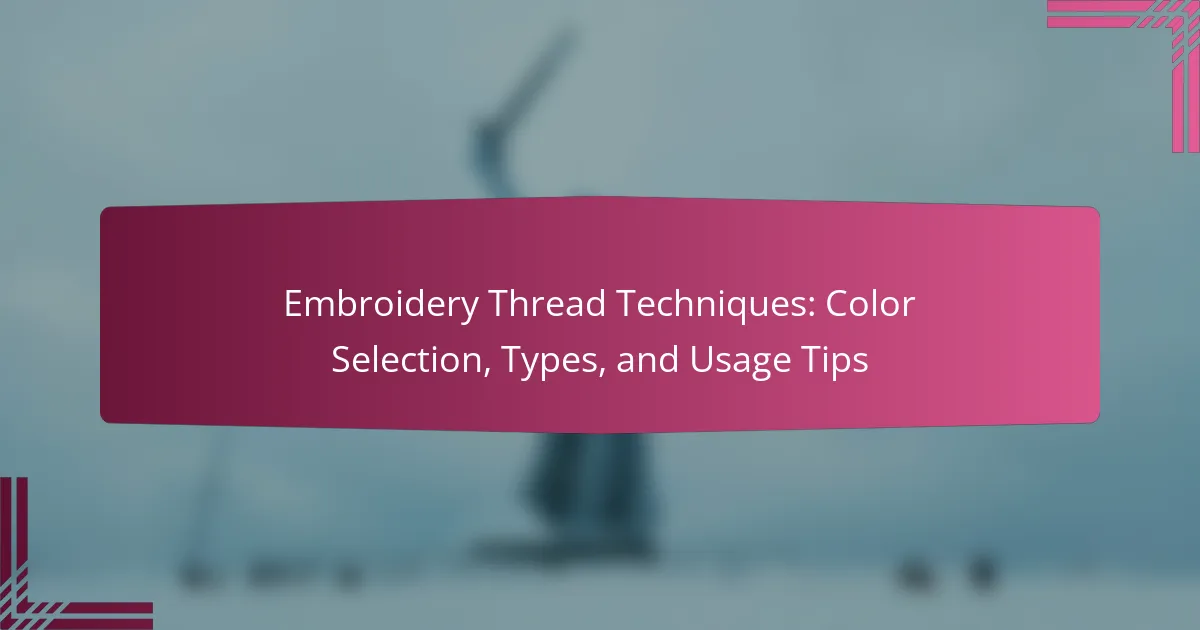
What are Embroidery Thread Techniques?
Embroidery thread techniques refer to various methods used in embroidery to manipulate thread for decorative purposes. These techniques include stitching styles like satin stitch, backstitch, and chain stitch. Each technique produces different visual effects and textures. For instance, satin stitch creates a smooth, shiny finish. Backstitch provides a defined outline, while chain stitch adds a textured appearance. Mastery of these techniques enhances the overall quality of embroidery projects. Additionally, the choice of thread type influences the outcome. Common thread types include cotton, polyester, and silk. Each thread type has unique properties affecting durability and sheen.
How do Embroidery Thread Techniques enhance textile art?
Embroidery thread techniques enhance textile art by adding texture, depth, and visual interest. These techniques allow artists to manipulate thread in various ways, creating intricate designs. Different stitch types, such as satin or chain stitches, contribute unique effects. Color selection plays a crucial role in this enhancement. It can evoke emotions and set the overall tone of the artwork. Additionally, layering threads can create a three-dimensional appearance. Historical examples show that skilled artisans have used these techniques for centuries to elevate their work. Overall, embroidery thread techniques are essential for transforming simple fabrics into stunning textile art.
What are the different styles of embroidery that utilize these techniques?
Different styles of embroidery that utilize these techniques include cross-stitch, satin stitch, and crewel work. Cross-stitch is characterized by its X-shaped stitches forming a grid pattern. Satin stitch involves smooth, flat stitches that create a polished look. Crewel work uses wool thread for intricate designs, often featuring floral motifs. Each style employs various thread techniques to enhance texture and visual appeal. For example, cross-stitch often uses multiple colors to create depth. Satin stitch can vary in width for different effects. Crewel work is known for its dimensional quality due to the wool’s thickness.
How do these techniques influence the overall design of a project?
Embroidery thread techniques significantly influence the overall design of a project. These techniques dictate the color palette and texture, shaping the visual appeal. For instance, the choice of thread type can affect the sheen and durability of the design. Specific color selections can evoke emotions and set the project’s tone. Techniques such as blending colors can create depth and dimension, enhancing the design’s complexity. Additionally, the application method, like satin stitch or chain stitch, alters the final appearance. Understanding these influences allows for more intentional design decisions. This knowledge leads to cohesive and aesthetically pleasing embroidery projects.
Why is color selection important in Embroidery Thread Techniques?
Color selection is crucial in embroidery thread techniques because it directly impacts the visual appeal and effectiveness of the design. The right colors can enhance contrast, create depth, and convey specific emotions or themes. For instance, high contrast between thread colors and fabric can make designs stand out more prominently. Additionally, color choices can influence the overall harmony of the piece, ensuring that the design is cohesive and aesthetically pleasing. Studies show that color psychology plays a significant role in how viewers perceive artwork, affecting their emotional response. Therefore, thoughtful color selection is essential for achieving desired artistic outcomes in embroidery.
What factors should be considered when choosing colors for embroidery?
Consider color harmony, contrast, and the fabric type when choosing colors for embroidery. Color harmony ensures that the selected colors complement each other. This can enhance the overall aesthetic of the design. Contrast is important for visibility and making the embroidery stand out. Fabrics can absorb or reflect colors differently, impacting the final appearance. Additionally, consider the color meaning and cultural significance, as this can affect the perception of the design. Thread material can also influence color appearance; for instance, polyester threads may have a different sheen compared to cotton threads. Finally, the intended use of the embroidered item may dictate color choices for appropriateness and appeal.
How do color combinations affect the final appearance of embroidery?
Color combinations significantly influence the final appearance of embroidery. They affect visual contrast, depth, and overall aesthetics. High contrast combinations, such as black and white, enhance visibility and detail. Conversely, similar shades may create a more subtle, blended effect. Color theory suggests that complementary colors can create vibrancy, while analogous colors provide harmony. The choice of colors can also evoke different emotions and perceptions. For example, warm colors tend to be inviting, while cool colors can appear calming. Research indicates that color combinations impact viewer perception and engagement, making thoughtful selection crucial for effective embroidery design.

What types of embroidery threads are available?
There are several types of embroidery threads available. Common types include cotton, polyester, rayon, and silk. Cotton threads are durable and widely used for various embroidery projects. Polyester threads are strong and resistant to fading, making them ideal for outdoor items. Rayon threads have a shiny finish and are often used for decorative embroidery. Silk threads offer a luxurious feel and a high sheen, suitable for high-end projects. Each type of thread has distinct characteristics that affect the final appearance of the embroidery.
What are the most common types of embroidery threads used?
The most common types of embroidery threads used are cotton, polyester, rayon, and silk threads. Cotton threads are widely favored for their durability and availability in various colors. Polyester threads are known for their strength and resistance to fading. Rayon threads offer a shiny finish and vibrant colors, making them popular for decorative work. Silk threads are prized for their luxurious feel and sheen but are less commonly used due to higher costs. Each type serves specific purposes in embroidery, catering to different project needs and preferences.
What are the characteristics of cotton embroidery thread?
Cotton embroidery thread is known for its softness and smooth texture. It is made from natural cotton fibers, which provide a matte finish. This type of thread is highly absorbent, allowing for vibrant dyeing. Cotton embroidery thread is also strong and durable, resisting fraying during stitching. It typically comes in various thicknesses, such as 30, 40, and 50 weight. The thread is easy to work with and can be used in various embroidery techniques. It is compatible with most embroidery machines and hand stitching methods. Additionally, cotton embroidery thread is less prone to fading compared to synthetic alternatives.
How does polyester thread differ from rayon in embroidery applications?
Polyester thread is more durable and resistant to fading compared to rayon in embroidery applications. Polyester has higher tensile strength, making it less likely to break during stitching. It also withstands exposure to sunlight and washing better than rayon. Rayon, while softer and offering a silk-like finish, is prone to fading and can lose strength when wet. Polyester thread is also more versatile for various fabrics, whereas rayon may be limited to specific materials. These differences make polyester a preferred choice for projects requiring longevity and colorfastness.
What specialty threads exist for unique embroidery effects?
Specialty threads for unique embroidery effects include metallic threads, variegated threads, and glow-in-the-dark threads. Metallic threads add shine and dimension to designs. Variegated threads provide a gradient effect through color transitions. Glow-in-the-dark threads create visibility in low light. Other specialty threads include bobbin threads for fine detail and heavy weight threads for bold designs. Each type enhances the visual impact of embroidery projects. The use of these threads can transform ordinary designs into extraordinary pieces.
What is metallic thread and how is it used in embroidery?
Metallic thread is a type of embroidery thread that contains metallic fibers. It is used to add shine and decorative elements to embroidery projects. This thread can be made from various materials, such as polyester or nylon, coated with a thin layer of metal.
In embroidery, metallic thread is often used for embellishments, highlights, or to create a shimmering effect on designs. It is popular in projects like holiday decorations, costume embellishments, and high-end fashion textiles.
When using metallic thread, it is essential to choose the right needle and tension settings. A larger needle can help prevent breakage, while lower tension can reduce friction. Many embroiderers also recommend using a stabilizer to support the fabric and thread.
Overall, metallic thread enhances the visual appeal of embroidery, making it a favored choice among crafters.
When should one use variegated thread in embroidery projects?
Variegated thread should be used in embroidery projects when a gradient or multi-colored effect is desired. This type of thread contains multiple colors that blend together seamlessly. It adds depth and visual interest to designs. Variegated thread is ideal for floral patterns, landscapes, and abstract designs. It can also enhance texture in stitching. Using it can save time by eliminating the need for changing threads frequently. The color variations can create a more dynamic look compared to solid colors.

How can one effectively use embroidery thread techniques?
To effectively use embroidery thread techniques, select the appropriate thread type for your project. Different threads, like cotton, polyester, and silk, have unique properties. Cotton is durable and versatile, while polyester offers sheen and strength. Consider color selection carefully to enhance your design. Use a color wheel to find complementary shades. Experiment with different stitch types, such as satin or backstitch, to create texture. Proper tension is crucial; adjust your machine settings accordingly. Finally, practice on scrap fabric to refine your skills and ensure quality results.
What are the best practices for using embroidery thread?
The best practices for using embroidery thread include selecting the right type of thread for your project. Use polyester or cotton threads based on fabric compatibility. Ensure proper tension settings on your sewing machine to avoid thread breakage. Use a needle that matches the thread weight; for example, a size 75/11 needle works well with lighter threads. Store threads in a cool, dry place to prevent damage from humidity and sunlight. Regularly check for fraying or wear before use to maintain quality. Follow these practices to achieve optimal results in your embroidery projects.
How should one prepare threads before starting an embroidery project?
To prepare threads before starting an embroidery project, first, choose the appropriate thread type for your fabric. This ensures compatibility and optimal results. Next, cut the thread to the desired length, typically between 18 to 24 inches. This length prevents tangling and allows for easier handling. Then, separate the strands if using multi-strand embroidery floss. Most floss comes in six strands, and you can use fewer for finer work. After separating, gently pull each strand to avoid fraying. Finally, thread the needle and tie a knot at the end to secure the thread. This process ensures that your threads are ready for smooth stitching.
What techniques can improve the quality of stitches in embroidery?
Using high-quality thread improves the quality of stitches in embroidery. Quality thread reduces fraying and breakage during stitching. Proper tension settings on the sewing machine also enhance stitch quality. Adjusting the tension ensures that stitches are neither too tight nor too loose. Using the correct needle size for the thread type is crucial. A suitable needle prevents fabric damage and ensures smooth stitching. Stabilizers can be used to support the fabric during embroidery. They help maintain the fabric’s shape and prevent puckering. Regular maintenance of the sewing machine, including cleaning and oiling, contributes to better stitch quality. These techniques collectively enhance the overall appearance and durability of embroidered designs.
What tips can help beginners master embroidery thread techniques?
To master embroidery thread techniques, beginners should focus on practicing basic stitches regularly. Consistent practice builds muscle memory and confidence in handling the thread. Selecting the right type of thread is crucial; cotton threads are versatile and easy to work with. Beginners should also use a needle that matches the thread thickness for optimal results. Understanding thread tension is important; too tight or too loose can affect the stitch quality. Experimenting with different colors can enhance creativity and visual appeal. Lastly, watching instructional videos can provide valuable visual guidance and tips.
How can beginners avoid common mistakes in thread selection?
Beginners can avoid common mistakes in thread selection by understanding thread types and their applications. Different threads serve specific purposes in embroidery. For instance, rayon threads are shiny but may not be suitable for all fabrics. Cotton threads are versatile and work well on various materials.
It’s essential to consider the weight of the thread. Using a thread that is too thick or too thin for the fabric can lead to poor results. Beginners should also check the colorfastness of the thread. Some threads may bleed or fade over time, affecting the final appearance of the embroidery.
Reading manufacturer guidelines can provide valuable information on thread compatibility with different fabrics. Testing thread on a fabric scrap before starting a project can help identify potential issues. Additionally, beginners should avoid mixing thread types without understanding their properties, as this can lead to inconsistent results.
What resources are available for learning advanced embroidery techniques?
Online platforms like Craftsy and Udemy offer courses on advanced embroidery techniques. These platforms provide video tutorials and structured lessons. Books such as “The Embroiderer’s Handbook” by Margie Bauer also serve as valuable resources. Additionally, YouTube has numerous channels dedicated to advanced embroidery methods. Local craft stores often host workshops for hands-on learning. Social media groups and forums can connect learners with experienced embroiderers. These resources ensure a comprehensive understanding of advanced techniques.
Embroidery Thread Techniques encompass various methods for manipulating thread in decorative embroidery, including stitching styles like satin stitch, backstitch, and chain stitch. This article explores how these techniques enhance textile art through texture, depth, and color selection, while also detailing the characteristics of different thread types such as cotton, polyester, and silk. Additionally, it discusses the importance of color combinations and provides practical tips for beginners to improve their embroidery skills. By understanding these elements, crafters can achieve high-quality, visually appealing embroidery projects.
